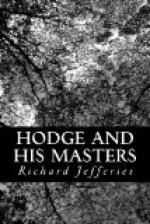To a spectator looking down upon mile after mile of such pasture land in summer from an elevation it resembles a park of illimitable extent. Great fields after great fields roll away to the horizon—groups of trees and small copses dot the slopes—roan and black cattle stand in the sheltering shadows. A dreamy haze hangs over the distant woods—all is large, open, noble. It suggests a life of freedom—the gun and the saddle—and, indeed, it is here that hunting is enjoyed in its full perfection. The labourer falls almost out of sight in these vast pastures. The population is sparse and scattered, the hamlets are few and far apart; even many of the farmhouses being only occupied by bailiffs. In comparison with a dairy farm there is little work to do. Cows have to be milked as well as foddered, and the milk when obtained gives employment to many hands in the various processes it goes through. Here the bullocks have simply to be fed and watched, the sheep in like manner have to be tended. Except in the haymaking season, therefore, there is scarcely ever a press for labour. Those who are employed have steady, continuous work the year through, and are for the most part men of experience in attending upon cattle, as indeed they need be, seeing the value of the herds under their charge.
Although little direct agitation has taken place in pasture countries, yet wages have equally risen. Pasture districts almost drop out of the labour dispute. On the one hand the men are few, on the other the rise of a shilling or so scarcely affects the farmer (so far as his grass land is concerned, if he has much corn as well it is different), because of the small number of labourers he wants.
The great utility of pasture is, of course, the comparatively cheap production of meat, which goes to feed the population in cities. Numbers of bullocks are fattened on corn land in stalls, but of late it has been stated that the cost of feeding under such conditions is so high that scarcely any profit can be obtained. The pasture farmer has by no means escaped without encountering difficulties; but still, with tolerably favourable seasons, he can produce meat much more cheaply than the arable agriculturist. Yet it is one of the avowed objects of the labour organisation to prevent the increase of pasture land, to stop the laying down of grass, and even to plough up some of the old pastures. The reason given is that corn land supports so many more agricultural labourers, which is so far true; but if corn farming cannot be carried on profitably without great reduction of the labour expenses the argument is not worth much, while the narrowness of the view is at once evident. The proportion of pasture to arable land must settle itself, and be governed entirely by the same conditions that affect other trades—i.e.. profit and loss.




